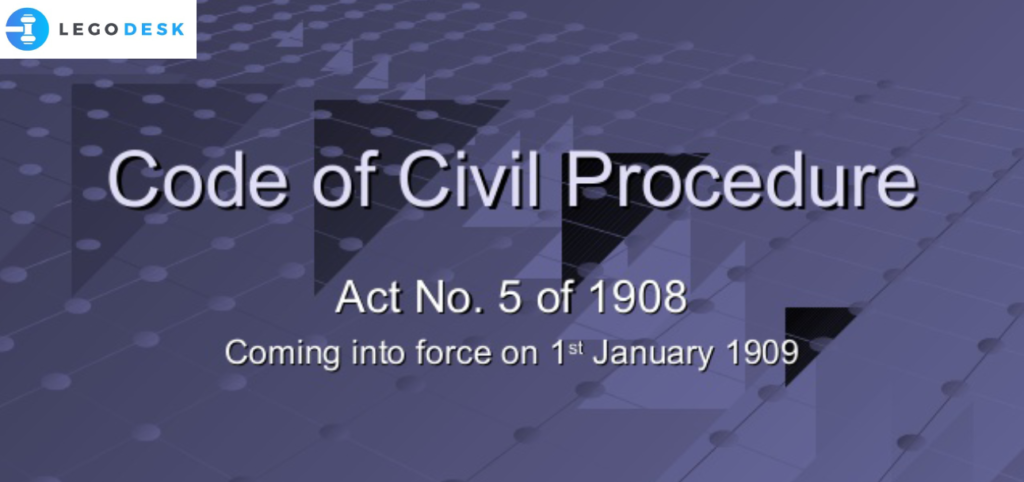CPC – Code of Civil Procedure 1908

Historical Background
Till 1859, in India, there was no uniform systematized law for the procedures to be followed in Civil Courts. In those past times, under the British standard, there were Crown Courts in Presidency towns and Provincial Courts in Mofussils.
- These Courts in Mofussil regions and Presidency towns were administered by various frameworks of Civil procedure through different guidelines, directions and special acts and those were changed on time to time premise based on conditions and needs.
- In 1859, a uniform civil procedure code was presented by passing the Civil Procedure Code (Act VII of 1859). Be that as it may, this code couldn’t fill the need as this code was not made relevant to the Supreme Courts (Crown Courts under the Royal Charter) and the Sadar Diwani Adalats (Principal Courts under the Judicial Plan by the Governor-General).
- In 1861, the Indian High Courts Act was passed and the Supreme Courts and Sadar Diwani Adalats were abolished. Then the High Courts were set up by supplanting the Supreme Courts at Madras, Bombay, and Calcutta. At that point, the Civil Procedure Code 1859 made relevant to these recently established High Courts.
- The Code of 1859 was altered consistently every once in a while and was supplanted by passing the Civil Procedure Code, 1877. This code of 1877 was revised in 1878 and 1879 and the third civil procedure Code was established in 1882, which supplanted the past code. The Code of Civil Procedure 1882 was additionally revised a few times and eventually the present code of Civil Procedure, 1908 was passed eclipsing the deformities of the Code of 1882.
a) Civil Procedure Court: Meaning and Object
The Law identifying with the practices and system to be followed in the Civil Courts is directed by the Code of Civil Procedure, 1908. The word CODE signifies ‘a systematic collection of statutes, a body of laws so arranged as to avoid inconsistency and overlapping‘.
The fundamental object of this civil procedure code is to unite and alter the laws identifying with the technique and practices followed in the Civil Courts in India. All things considered, it was cherished in the preamble of the code that it was instituted to combine and revise the laws identifying with the methodology to be followed in the civil courts having civil jurisdiction in India. The Civil Procedure Code directs each activity in civil courts and the gatherings previously it till the execution of the degree and order.
Read Also: Understanding the Civil Laws in India
The Aim of the Procedural law is to execute the standards of Substantive law. This Code guarantees fair justice by upholding the rights and liabilities.
b) Extent and Application
The Civil Procedure Code was passed in 1908 and came into power from first January 1909. The Code is pertinent to the entire nation with the exception of –
The State of Jammu and Kashmir
The state of Nagaland and the tribal regions
There is additionally a provision that the concerned state governments may make the provisions of this code pertinent to the entire or part of the State of Nagaland or such tribal regions by notification in the official gazette.
This code is pertinent in the scheduled zones of the previous State of Madras (Lakshadweep), the East Godavari, West Godavari and Visakhapatnam agencies (Now in Andhra Pradesh State).
Salient Features
- The Civil Procedure Code made the procedure to be followed in the Civil Courts very basic and compelling. Authorization of rights, liabilities, and commitments of the citizens are managed by this code. To state, as such, the Civil Procedure Code gives the component to the implementation of rights and liabilities.
- The Civil Procedure Code is a general law and won’t influence any laws which are as of now in force. If there should arise an occurrence of any contention with any other laws, the other law will prevail in the Civil Procedure Code. On the off chance that, in the event that the other law is quiet about a specific issue, the Civil Procedure Code will apply.
- The Civil Procedure Code has been amended a few times to address the issues and prerequisites which are dynamic and changing every once in a while. Between 1909 to 1976, the Code has been amended for more than 30 times.
Conclusion
To empower the courts to convey fair-minded and unprejudiced equity, the Code of Civil Procedure, 1908 gives straightforward and clear procedures to be trailed by the Civil Courts. If there should be an occurrence of no provisions identifying with some issue or matter, the court won’t most likely decide effectively.
Consequently the Code of Civil Procedure, 1908 consolidated the provisions for inherent powers. At the point when there is no enactment, the court, in light of a legitimate concern for equity may exercise the discretionary power by acting past the powers given to them under the Code of Civil Procedure. It is known as the Inherent powers of the Court.
The Code of Civil Procedure is one of the vital parts of procedural laws and it is the one regulating the method to be trailed by the Civil Courts in India. Despite the fact that it might have a few restrictions, however, it is as yet effective, basic, clear and empowers the courts to deliver fair-minded equity and impartial justice.
Try our Debt Resolution solutions today Request a Demo